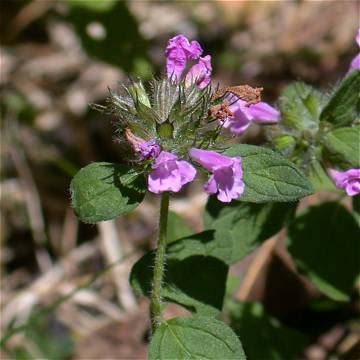

Satureja vulgaris - (image 1 of 5)
Taxonomy
Family: Lamiaceae
Habitat
Roadsides, pastures, thickets. Upland woods.
Associates
Anemone cylindrica, Carya obata, Euonymus atropurpureus, Geranium maculatum, Krigia biflora, Liparis lilifolia, Quercus alba, Toxicodendron radicans, Tilia americana. Asimina triloba, Celtis occidentalis, Erigeron annuus, Galium triflorum, Geum canadense, Lindera benzoin, Morus rubra, Phryma leptostachya, Prunella vulgaris lanceolata, Ulmus rubra.
Distribution
Newfoundland and Quebec west to Manitoba, south to NC, TN, and KS. Also scattered in the western U.S. and widespread in Europe.
Morphology
Herbaceous perennial from short stolons, to 18" high. Stems square, hairy. Leaves opposite, mostly entire broadly elliptic-ovate, petiolate or subsessile, to 1.5" long. Flowers pink-purple, about 0.5" long, bilabiate, subtended by hairy bracts; numerous in a rounded, terminal, head-like inflorescence, sometimes with smaller clusters in the upper leaf axils; sepals hairy; stamens 4.
Notes
Flowers late June to early August
Wetland indicator: Upland
This plant is also native to Europe and those from the southern part of our range may have been introduced. It is also called Clinopodium vulgare. The dried leaves can be used as a seasoning, similar to commercial basil but not as strong. The fresh leaves may also be used to make an infusion.
References
Gleason, Henry A. and A. Cronquist. 1991. Manual of Vascular Plants of
Northeastern United States
and Adjacent Canada. Second Ed.
The New York Botanical Garden. Bronx, NY
Niering, W. A. 1979. The Audubon society field guide to North American
wildflowers: eastern region.
Knopf/Random House, New York.
Peterson, L. A. 1977. A Field Guide to Edible Wild Plants: Eastern and central
North America
Houghton Mifflin Company. New York, NY
Swink, F. and G. Wilhelm. 1994. Plants of the Chicago Region.
Indiana Academy of Science. The Morton Arboretum. Lisle, Illinois.
|
Michael Hough © 2005 |